

A Team of Biohackers Has Figured Out How to Inject Your Eyeballs With Night Vision. In "people becoming superhuman" news, a small independent research group has figured out how to give humans night vision, allowing them to see over 50 meters in the dark for a short time.

Science for the Masses, a group of biohackers based a couple hours north of Los Angeles in Tehachapi, California, theorized they could enhance healthy eyesight enough that it would induce night vision. To do this, the group used a kind of chlorophyll analog called Chlorin e6 (or Ce6), which is found in some deep-sea fish and is used as an occasional method to treat night blindness. "Going off that research, we thought this would be something to move ahead with," the lab's medical officer, Jeffrey Tibbetts, told Mic. The DIY Cyborg. Humanity just made a large, DIY step towards a time when everyone can upgrade themselves towards being a cyborg.

Of all places, it happened somewhere in the post-industrial tristesse of the German town of Essen. It's there that I met up with biohacker Tim Cannon, and followed along as he got what is likely the first-ever computer chip implant that can record and transmit his biometrical data. Ultra-thin e-skin could lead to advances in medicine, cool wearable computing (video) Remember the names Martin Kaltenbrunner and Takao Someya -- that way, you'll have someone to blame when kids start pointing and laughing at gadgets we consider high-tech today.
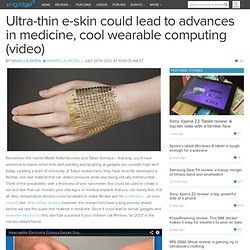
Leading a team of University of Tokyo researchers, they have recently developed a flexible, skin-like material that can detect pressure while also being virtually indestructible. Scientists Create Sensor As Sensitive As Real Skin. [Source: Georgia Tech] While prosthetic limbs continue to improve, tactile feedback is one feature that many are keen to incorporate into the prosthetics but it remains a very difficult technology to develop.
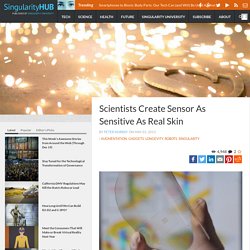
But now scientists have developed a new device so packed with sensors it is about as sensitive as human skin. Just as Moore’s Law continues to benefit the integrated circuit, packing ever more sensors into a smaller area will allow such devices to one day be built into everything we touch. Bionic superhumans are on the horizon. The i-limb ultra revolution hand, controllable by smartphone app.

Wearable Electronic Sensors Can Now Be Printed Directly on the Skin. Taking advantage of recent advances in flexible electronics, researchers have devised a way to “print” devices directly onto the skin so people can wear them for an extended period while performing normal daily activities.
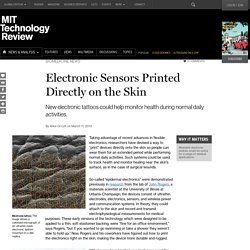
Such systems could be used to track health and monitor healing near the skin’s surface, as in the case of surgical wounds. So-called “epidermal electronics” were demonstrated previously in research from the lab of John Rogers, a materials scientist at the University of Illinois at Urbana-Champaign; the devices consist of ultrathin electrodes, electronics, sensors, and wireless power and communication systems. In theory, they could attach to the skin and record and transmit electrophysiological measurements for medical purposes. Flip of a single molecular switch makes an old brain youn. The flip of a single molecular switch helps create the mature neuronal connections that allow the brain to bridge the gap between adolescent impressionability and adult stability.
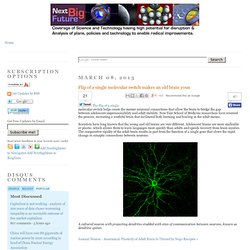
Now Yale School of Medicine researchers have reversed the process, recreating a youthful brain that facilitated both learning and healing in the adult mouse. Scientists have long known that the young and old brains are very different. Adolescent brains are more malleable or plastic, which allows them to learn languages more quickly than adults and speeds recovery from brain injuries.
The comparative rigidity of the adult brain results in part from the function of a single gene that slows the rapid change in synaptic connections between neurons. A cultured neuron with projecting dendrites studded with sites of communication between neurons, known as dendritic spines. Journal Neuron - Anatomical Plasticity of Adult Brain Is Titrated by Nogo Receptor 1 Highlights Summary SOURCE - Yale University, Journal Neuron. Newt Finding Might Set Back Efforts to Regrow Human Limbs. The ability of some animals to regenerate tissue is generally considered to be an ancient quality of all multicellular animals.
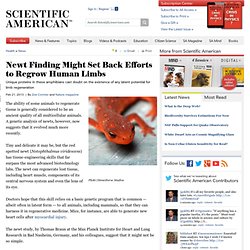
A genetic analysis of newts, however, now suggests that it evolved much more recently. Tiny and delicate it may be, but the red spotted newt (Notophthalmus viridescens) has tissue-engineering skills that far surpass the most advanced biotechnology labs. The newt can regenerate lost tissue, including heart muscle, components of its central nervous system and even the lens of its eye. Doctors hope that this skill relies on a basic genetic program that is common — albeit often in latent form — to all animals, including mammals, so that they can harness it in regenerative medicine.
Movement. Prosthesis. Safe SIRTUIN activating drugs could be available in five years and effective Sirtuin drugs could help people live to 150 years old. Publishing his work in the prestigious journal Science, David Sinclair of Harvard reports a breakthrough in the development of drugs that can block the aging process.

Amputee Coalition - Resources for amputees, amputation, limb loss, caregivers and healthcare providers.
Practical transhumanism: five living cyborgs. The term "cyborg" literally means "cybernetic organism" -- a being constructed of both mechanical and organic material.

Although traditionally confined to the realms of science fiction, modern medicine and in particular prosthetics have made the term applicable to a number of human beings.